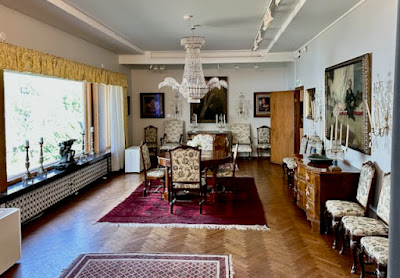°
All these islands belong to Helsinki.
Kuusisaari and Lehtisaari are some quite exclusive residential areas.
Many Embassies are located on the islands, too.
Kuusisaari.
Finnisch für Anfänger:
KUUSI = Fichte / spruce
SAARI = Insel / island
There are also two quite interesting art exhibitions.
In their webpage they say:
Villa Gyllenberg offers meaningful experiences of
beauty, knowledge and mindful presence.
The art collection of the Signe and Ane Gyllenberg Foundation
includes mainly Finnish art works. Isaac Wacklin’s Portrait of a Man (1756)
is one of the oldest pieces, and Juhani Linnovaara’s surrealistic paintings,
done in the 1960's, among the latest. The so called golden age of Finnish art
and modernism are well represented. Nearly 40 works of Helene Schjerfbeck
form the museum’s biggest collection of an individual artist.
Väinö Aaltonen: Indian Sinchi.
Akseli Gallen-Kallela: Beggar Boy
Essi Renvall: Hannu
In the new wing there was a special exhibition:
Eastern Spirituality
Answers to the challenges of today's hectic lives are often sought
in yoga, meditation, trips to the East Asia and homes decorated with
images of Buddha. This exhibition provides an art and cultural
historical overview of how 'Eastern spirituality' has been imagined
in Finnish art from the late 19th century to the 1990’s.
Above in the pic works of Outi Heiskanen.
Rudolf Koivu: Wonder's Wonder I
Off we went to the second exhibition hause on the island.
DIDRICHSEN
The collection of around one thousand artworks in the Didrichsen
Art Museum is a result of active collecting during several decades.
The majority of the works have been acquired by museum founders
Gunnar and Marie-Louise Didrichsen for their personal enjoyment.
They started collecting in the 1940s and the choices reflect their artistic
tastes, which is evident even today in the exhibition programme.
After the founders passed away, most of the new acquisitions
have been made from exhibitions organised at the museum.
When entering the premises Henry Moore is greeting you.
OMG
Henry Moore indeed.
The building as such is also very interesting.
Architect Viljo Rewell.
The first part of the house was completed in 1957 as the home
for the Didrichsen family. Later Revell designed an extension for
the growing art collection. The museum wing was completed in 1964.
The collecting couple seen by the Finnish sculptor
Laila Pullinen.
Another work by Laila Pullinen.
Yes, Giacometti. WOW.
Yes, Dali. WOW WOW.
Juhani Linnovaara: Naisen muotokuva.
Another Henry Moore. WOW.
Yes, Henry Moore as well!
And where did the money come from?
From business, naturally.
Transmeri is an import company still going strong.
Transmeri products from older days.
In the garden there are many more sculptures to be wondered.
Check the webpage for all of them, well done, must say.
This year marks the 60th anniversary of the foundation,
the 120th anniversary of Gunnar's (1903–1992) birth and
the 110th anniversary of Marie-Louise's (1913–1988) birth.
The couple will also be represented in the exhibition
through material selected from the museum's archives.
Check the internet pages for both collections,
there are language options, go ahead.
I only posted a few pics of the art works.
Vahva suositus.
This year marks the 60th anniversary of the foundation, the 120th anniversary of Gunnar's (1903–1992) birth and the 110th anniversary of Marie-Louise's (1913–1988) birth. The couple will also be represented in the exhibition through material selected from the museum's archives.
























1 kommentti:
Nämä kaksi museota eivät oikeastaan ole museita vaan elämyksiä jonkun kodissa.
-Mur
Lähetä kommentti